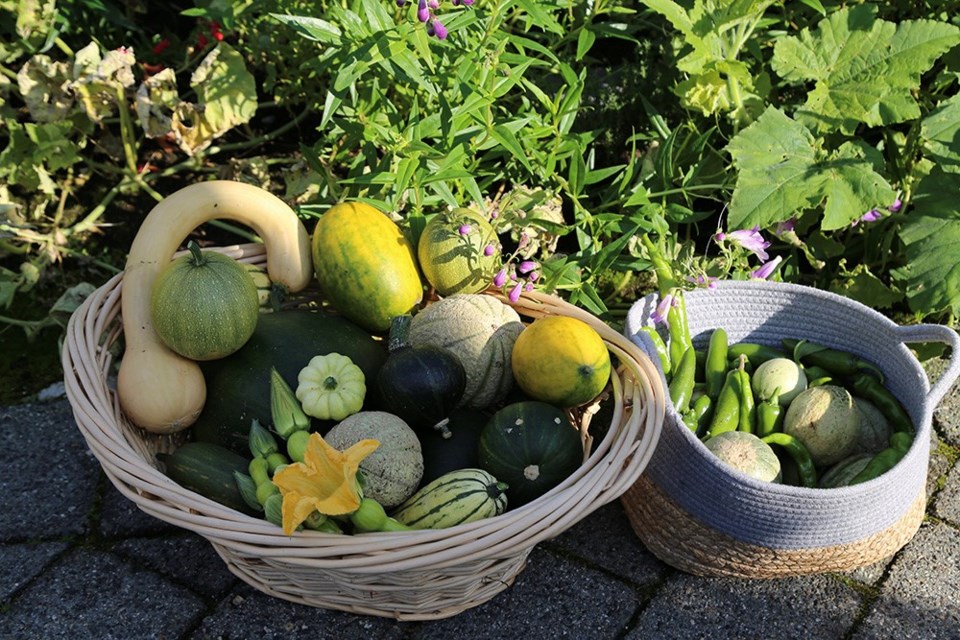This pre-Thanksgiving week I’ve been busy cleaning out garden beds, potting-up winter seedlings started from seed in the greenhouse, and generally chasing my tail. Time has passed by in a blink of an eye; wasn’t it just July?
Yesterday I harvested a final bounty of sweet melons, squash and hot chili peppers from the tiny new "edible ecosystem" that I planted just three months ago in a spot that was formerly a barren patch of grass wedged between a bend in the driveway.
I’ve written before about the making of the new ecosystem — articles riddled with angst, composed under duress and climate change stress. Admittedly, my emotions got the best of me during those few mid-summer days when we experienced the worst heat wave in recorded local history; when wildfires burned out of control, the small town of Lytton burned to the ground in a matter of hours, and 570 Lower Mainland residents died of heat wave-related causes.
My knee-jerk response typically, to troublesome things I cannot change, is to retreat to the greenhouse and listen to consecutive podcasts of BBC World Service. On that day, the greenhouse was insufferably hot and could not have in any case contained my anxiety, so my response was to fill a thermos bottle with ice water, head straight for the un-shade, and start to dig.
Over the course of a few unbearably hot and humid days, I dug, turned, and stacked dense blocks of sod to form the foundation of a hybrid hugelkultur and lasagna-layered mound of heavily composted nourishment, into which I planted all manner of seeds, and transplanted every runt vegetable and perennial flower seedling left behind in the greenhouse.
A dwarf Fuyu persimmon tree, formerly potted and dissatisfied in its increasingly shaded location, assumed pride of place at the top of the mound, flanked by two each wilty and orphaned goji berry and thornless blackberry starts. The haphazard design process was contemplative and intensely healing, rather like self-directed garden therapy.
The magic of permaculture did not disappoint, and within a few short weeks, the tiny, scrappy, edible ecosystem grew beautifully lush and began to thrive — as if in living, breathing thanks for bringing it to life.
For two months now, I have been harvesting almost daily from that small garden of goodness — white eggplant, golden pearls, hot chili and sweet bell peppers, strawberries, miniature summer and winter squash, fresh herbs, spinach, dwarf blackberries and so much more.
What surprised me most was the quantity of Sugar Baby and Black Beauty watermelons, Diana melons, and Halona cantaloupe that appeared on the sunniest side of the part-sun mound, and the speed at which they grew to considerable size, ripening almost fully.
I am quite certain that, in exchange for nourishing a barren and unproductive space into habitat for pollinators, birds and butterflies, nature rewarded me with uncommon abundance. Hummingbirds visit daily, pollinator-friendly flowers light up the shade, and a sprawling mixed forest of fungi hints at the widespread mycelial network taking shape below.
This weekend I will cut and compost annual vegetable foliage, and plant a cover crop of winter field peas. A shallow carpet of emerald green moss has appeared at the base of the mound, and will ascend over time to form a living mulch. In the interim, winter peas will provide erosion control and help the ecosystem maintain its structure over what promises to be a punishing winter of extreme rain events and repeated freeze-thaw cycles.
Our Thanksgiving dinner will be modest this year, with the children adventuring or away at school, and friends and family scattered hither and yon. Our table will be merry all the same — punctuated by colourful melons and squash, tiny creamy white eggplant, and the many blessings and bounty of our urban permaculture gardens.
My takeaways this garden season relate to resilience and gratitude, and to the many physical, emotional, and spiritual rewards of creating small change for the better. For me all it took was a barren patch of grass, a collection of tree trimmings and green garden refuse, remnant seeds, cast-off seedlings and perennials, and one badly needed session of intense garden therapy.
Happy Thanksgiving. I wish you nourishment, peace and happiness.
Laura Marie Neubert is a West Vancouver-based urban permaculture designer. Follow her on Instagram @upfrontandbeautiful, learn more about permaculture by visiting her Upfront & Beautiful website or email your questions to her here.
For a taste of permaculture, click on the YouTube link below:
(Video - Courtesy of West Vancouver Memorial Library)



